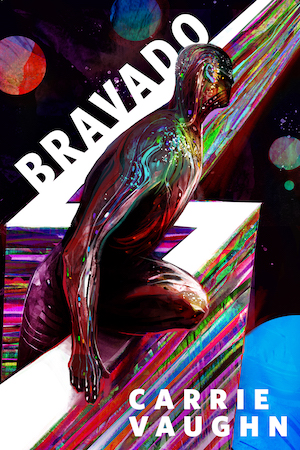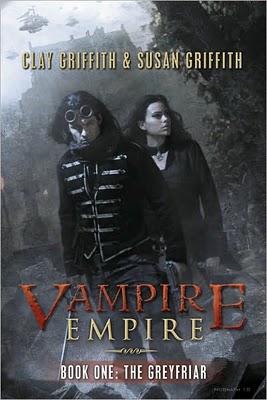Harkening back to classic vampire tales, Clay and Susan Griffith’s The Greyfriar (Vampire Empire, Book 1) is a delightful, entirely non-sparkly, gritty vampire tale on a grand and sweeping scale and a great look at what humanity means. This is no “vampires are integrated into our society!” story, but one of devastation, fear, romance and airships. The main character, Princess Adele, who is heir to the Equatorian Empire—one based in Egypt, founded from the remains of the British Empire—is struggling with her heritage and duties. Engaged to Senator Clark, an American war hero, to form an alliance between the two super-powers and about to form a marriage that will precipitate a world-devastating war against the vampires, Adele is strong and powerful from the very beginning.
The Greyfriar is an alternate history in which vampires rule most of the North while humans have retained and grown power in the Southern Hemispheres. The vampires, a different race, have significantly greater senses—except that of touch. Without much elaboration, the authors paints this monsters as entirely different from humans in fascinating ways, from the very beginning.
With some brilliantly placed foreshadowing and subtle twisting of expectations, the Griffith’s start blurring the divisions and delineations they just set up, as well as the genres they play with. The titular hero, Greyfriar—so named for a small human church he cares for—is a dashing hero out of a romance novel, set largely against the brooding and dramatic Scottish climes, while the powerful Adele is a heroine worthy of an adventure novel. In addition, the setting is a lovely cross of horror and steampunk. The story is a self-contained and neatly concluded adventure—kidnap and rescue/escape—but the book contains seeds that show the beginnings of a much larger story on a large and fascinating scale. There are hints of racial and inter-empire politics, tantalising teases about magic and religion, as well as glimpses into the powers that Adele herself has but doesn’t understand yet.
The relationship between Greyfriar—and his alter-ego—and Adele is one of the true gems in this book. The initial, girlish fascination, followed by the betrayal as truths emerge is pretty standard for a romantic plot, but rather than following romance heroines into blind forgiveness and lust, Adele slowly re-learns just who Greyfriar is as a person and comes to truly love him for who he is, not the romanticized ideal she’d originally thought.
This slow growth of maturity is evident not only in her relationships, but also in her character. It is no wonder that Greyfriar falls so in love with her so quickly; it’s almost impossible not to do so as the reader, too. Adele holds a special place in my heart for the slow and painful way she grows and becomes a brilliant heroine—and a kind, thoughtful one. She actively listens and learns—both to vampires and humans from different walks of life than her own—and then uses that to become stronger and fight her own battles. Over the course of this trilogy she is going to become a force to be reckoned with in world, and a heroine to be lauded in the literary vampire canon.
The entire cast of characters are almost uniformly gush-worthy, with particular love for Cesare’s war chief, the monstrous, yet passionate Flay, and the Ghurka Colonel Anhalt. Only such a bright and varied cast could hold their own against the fascinating backdrop of the setting and the epic politics which hint at the greater plot and intrigue of the trilogy. I wanted to focus on one small facet of the politics at play that fascinated me. The brash American, Clark, brags about their new chemical warfare—and propulsion among other things—while the Equatorians stick, steadfastly, to their steam-powered methods. It’s a small section in book one, though it’s going to come to play a larger role in later books, but as the characters grow and mature, we also see the world changing and moving into the future. As far as I’ve found, this realistic look at great moments in history—and particularly in alternate histories—The Greyfriar is unique among its kind. It may be the only steampunk-esque book that deals with emerging and alternate technologies and doesn’t let the world and its people stagnate. As well as promoting a future of improved harmony—or at least reduced butchery—it begins to deal with societies on the brink of great change culturally as well.
Nina Lourie swashed and buckled her way through The Greyfriar with fangs out and Spiced Cranberry Cider in her goblet. It’s looks like blood and tastes like the most delicious farm hand you could nibble on!










